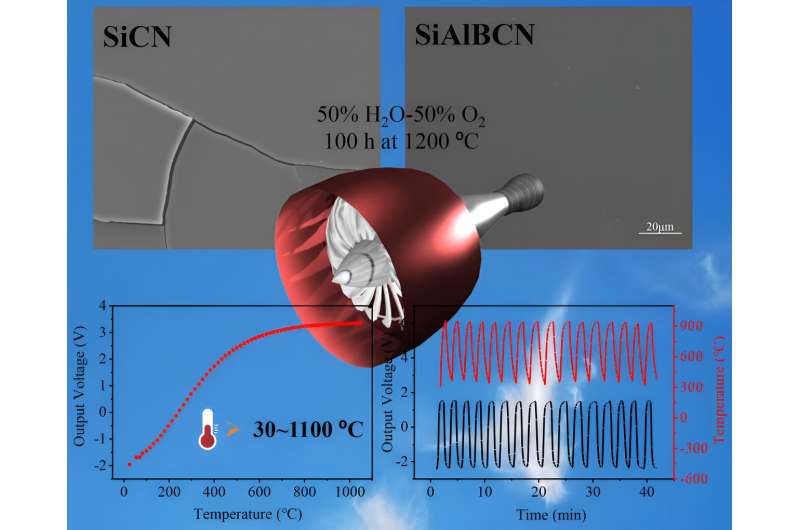This article has been reviewed according to Science X's editorial process and policies. Editors have highlighted the following attributes while ensuring the content's credibility:
fact-checked
proofread
Research investigates structural evolution and high-temperature sensing performance of polymer-derived SiAlBCN ceramics

Gang Shao's group from Zhengzhou University, China recently investigated the structural evolution of pentagonal polymer-derived SiAlBCN ceramics (PDCs) and outlined PDC-based sensor technology for high-temperature extreme environments. The high-performance temperature sensing materials including high sensitivity, fast response, wide detection range are scarce and needing.
This research developed a ceramic-based temperature with attractive performance that can be applied in high-temperature environments of 1100 °C. This sensor has great potential for in-situ monitoring of extreme environmental temperatures including high temperature, high pressure, strong oxidation/corrosion circumstance.
The team published their paper in Journal of Advanced ceramics on April 30, 2024.
For the accurately monitor of information on the surface temperature of key hot end components of aircraft engines, it is crucial to evaluate the combustion efficiency of gas, monitoring engine operation status, and fault diagnosis, so that the thermal mechanical modeling and simulation, the cooling effect of gas film cooling technology and the performance of thermal barrier coatings can be verified.
"However, it is still very difficult to accurately obtain information such as temperature and pressure in the extremely harsh working environment," said Gang Shao. "Polymer-derived ceramics (PDCs) as sensing materials have been considered promising candidates for monitoring temperature signals due to their excellent thermal stability, good corrosion/oxidation resistance, creep resistance, and high temperature semiconductor characteristics."
This work presents the preparation of the polymer-derived SiAlBCN ceramics at different pyrolysis temperatures. Their structural evolution is analyzed systematically and the results show that the size of the free carbon phase enlarges with the increasing temperature and the amorphous SiAlBCN phase became more ordered with the structural reassembly.
"Compared to SiCN and SiBCN ceramics, SiAlBCN PDCs exhibits excellent oxidation/corrosion resistance, which was related to their low oxidative rate constant (3.43 mg2/(cm4·h)) and volatilized rate constant (0.57 mg/(cm2·h)), guaranteeing that they could survive well in extreme environments," said Gang Shao.
"The fabricated SiAlBCN temperature sensor possesses excellent stability, repeatability, and accuracy and can work within the maximum temperature of 1100 °C, which can operate positively in extreme environments such as aeroengines, nuclear reactors, and hypersonic vehicles in the future.
"In the future, our team will continue to focus on the development of temperature sensor that can be applied in higher temperature. To prevent from the trouble caused by wired sensor, the wireless and passive sensor will be researched to realize advanced signal detection."
Other contributors include Chao Ma, Kun Liu, Pengfei Shao, Daoyang Han, Kang Wang, Mengmeng Yang, Rui Zhao, Hailong Wang, Rui Zhang from School of Material Science and Engineering at Zhengzhou University, China.
More information: Chao Ma et al, Structural evolution and high-temperature sensing performance of polymer-derived SiAlBCN ceramics, Journal of Advanced Ceramics (2024). DOI: 10.26599/JAC.2024.9220870
Provided by Tsinghua University Press




















